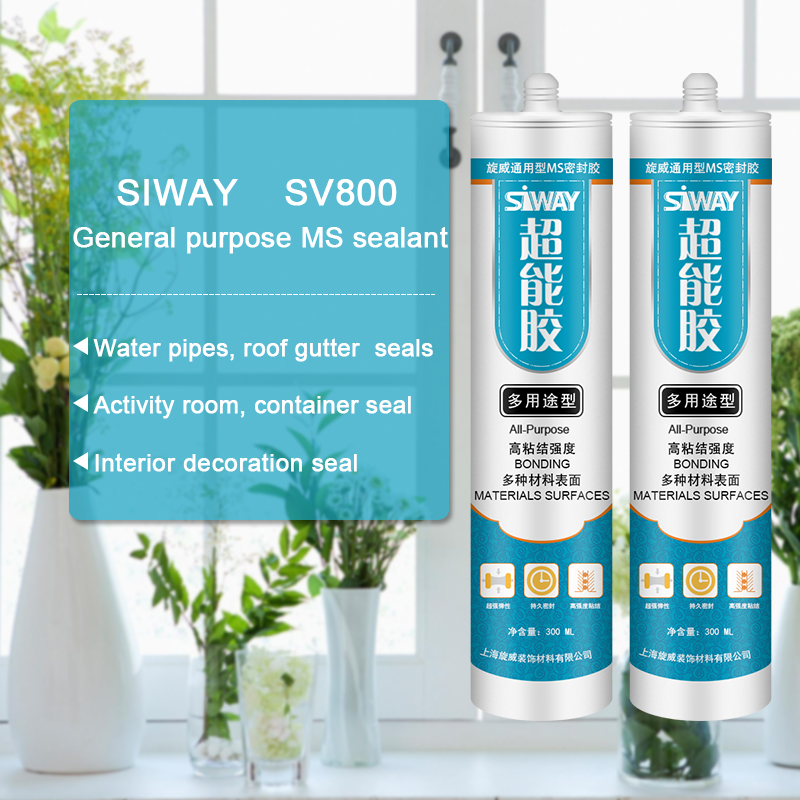Factory Free sample SV-8800 Silicone Sealant for Insulating Glass to Barbados Importers
Short Description:
Description SV-8800 is two components, high modulus; neutral curing silicone sealant specifically developed for assembly of high performance insulated glass units as secondary sealing material. Where to use It is a two-component silicone that offers variable work life with high bonding strength to maintain the integrity of insulating glass unit, suits both commercial and residential IGU. Key Features 1. High Modulus 2. UV resistance 3. Low vapor and gas transmission 4. Primerless adhesion...
Reliable quality and good credit standing are our principles, which will help us at a top-ranking position. Adhering to the tenet of "quality first, customer supreme" for Factory Free sample SV-8800 Silicone Sealant for Insulating Glass to Barbados Importers, We are confident that there will be a promising future and we hope we can have long term cooperation with customers from all over the world.
Description
SV-8800 is two components, high modulus; neutral curing silicone sealant specifically developed for assembly of high performance insulated glass units as secondary sealing material.
Where to use
It is a two-component silicone that offers variable work life with high bonding strength to maintain the integrity of insulating glass unit, suits both commercial and residential IGU.
Key Features
1. High Modulus
2. UV resistance
3. Low vapor and gas transmission
4. Primerless adhesion to coated glass
5. 100% compatible to SV-8890
Technical data sheet
| Test standard | Test project | Unit | value |
| Before curing——25℃,50%R.H. | |||
| GB13477 | Specific gravity(After mixing) | 1.33 | |
| GB13477 | Operating time | min | 20-40 |
| GB13477 | surface drying time(25℃,50%R.H.) | min | 80-188 |
| corrosivity | No | ||
| 7 days after curing——25℃,50%R.H. | |||
| GB/T 531 | Durometer Hardness | Shore A | 40 |
| GB13477 | The tensile modulus at 12.5% elongation | Mpa | 0.18 |
| The ultimate tensile strength | Mpa | 0.92 | |
| GB13477 | Elongation limit (fracture) | % | 150 |
Certification
GB-24266-2009;
Color
Component A(Base) – White, Component B(Catalyst)- Black
Package
1. Component A(Base): (190L), Component B(Catalyst) (18.5L)
2. Component A(Base):24.5kg (18L), Component B(Catalyst): 1.9kg (1.8L)
Shelf life
12 months
Note
If you want the TDS or MSDS or other details, please contact with our sales person.
The finished product of our Adams Polishes video shoot! Huge shout out to Blake for filming and editing everything and to Hunter for being gorgeous and washing my car haha everyone will be tagged below so check them out and their channels!
Products – @AdamsPolishes instagram
Youtube channel – https://www.youtube.com/user/Adamspolishes
Filmed by – @StevenBlakeM Instagram
Youtube channel – https://www.youtube.com/channel/UCzTTU70hQ8VbMQdzNg4CdZg
Model – @ihunter_Rae instagram
Youtube Channel – https://www.youtube.com/channel/UCfbEerwCw3vkl0IutVnKtWg
Song – https://soundcloud.com/illeniumofficial/odesza-always-this-late-illenium-remix-1
I think the well system made of Duct Seal is the best for installing a transducer on a kayak hull. (thru-hull).
I is easy to make, easy to undo or redo. No tools are required at all. No sanding no heavy cleaning required at all. It is the cheapest and the fastest. There is no waiting time. You make it and go fish.
Though, I found that gluing the transducer on the hull, regardless of glue types (including Duct Seal), is not quite dependable. Because there is an inherent problem that is air pockets or air bubbles form between the hull and the transducer.
Build a well for the transducer and fill the well with water is the best way to achieve consistent and accurate readings for a long period of time.
On the video, I explained and demonstrated why a transducer well made of Duct Seal is the best way for installing a transducer on a kayak hull.
Joe





